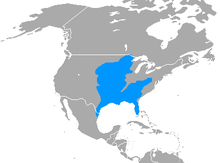
Back ظربان مرقط شرقي Arabic ظربان مرقط شرقى ARZ Krijol (Spilogale putorius) AVK سپیلوقال پوتوریوس AZB Петнист скункс Bulgarian Skoñs brizh ar reter Breton Mofeta tacada oriental Catalan Spilogale putorius CEB Skunk skvrnitý Czech Östlicher Fleckenskunk German
| Eastern spotted skunk | |
|---|---|

| |
| Scientific classification | |
| Domain: | Eukaryota |
| Kingdom: | Animalia |
| Phylum: | Chordata |
| Class: | Mammalia |
| Order: | Carnivora |
| Family: | Mephitidae |
| Genus: | Spilogale |
| Species: | S. putorius
|
| Binomial name | |
| Spilogale putorius | |

| |
range of Spilogale putorius
| |
| Synonyms | |
|
Viverra putorius Linnaeus, 1758 | |

The eastern spotted skunk (Spilogale putorius) is a small, relatively slender skunk found in North America, in the central and parts of the southeastern United States and in small areas of Canada and Mexico.
The eastern spotted skunk is a very small skunk, no larger than a good-sized tree squirrel.[3][4] Its body is more weasel-like in shape than the more familiar striped skunk. The eastern spotted skunk has four broken stripes on its back,[3] giving it a "spotted" appearance. It has a white spot on its forehead. It is found in Canada (southeast Manitoba and northwestern Ontario), the United States and northeastern Mexico.[1] Males, at 46.3–68.8 cm (18.2–27.1 in) in total length, are larger than females, at 35–54.4 cm (13.8–21.4 in).[3] The tail accounts for roughly a third of its total length. Body mass can range from 0.2 to 1.8 kg (0.44 to 3.97 lb), with males averaging around 700 g (1.5 lb) against the female's average of 450 g (0.99 lb).[5] Skull length is 43–55 mm (1.7–2.2 in).[6]
It is much more active than any other type of skunk. It has mostly the same predators as any other skunk (big cats, bobcats, owls, humans, etc.). Up to eight skunks may share an underground den in the winter. It can also climb and take shelter in trees.[7]
The Eastern spotted skunk seems to prefer forest edges and upland prairie grasslands, especially where rock outcrops and shrub clumps are present. In western counties, it relies heavily on riparian corridors where woody shrubs and woodland edges are present. Woody fencerows, odd areas, and abandoned farm buildings are also important habitat.[citation needed]
- ^ a b Gompper, M.; Jachowski, D. (2016). "Spilogale putorius". IUCN Red List of Threatened Species. 2016: e.T41636A45211474. doi:10.2305/IUCN.UK.2016-1.RLTS.T41636A45211474.en. Retrieved 13 November 2021.
- ^ "NatureServe Explorer 2.0". explorer.natureserve.org. Retrieved 4 April 2022.
- ^ a b c Cite error: The named reference
whit2010Awas invoked but never defined (see the help page). - ^ Jay Butfiloski; Tom Swaygnham. "Eastern Spotted Skunk" (PDF). www.dnr.sc.gov. Archived from the original (PDF) on 19 January 2022. Retrieved 30 December 2021.
- ^ "Species Information: Eastern spotted skunk (Spilogale putorius putorius)". Archived from the original on 2011-12-07. Retrieved 2012-04-02.
- ^ Hunter, Luke (2011). Carnivores of the World. Princeton University Press. ISBN 978-0-691-15228-8.
- ^ Diggins, Corinne A.; Jachowski, David S.; Martin, Jay; Ford, W. Mark (2015). "Incidental Captures of Eastern Spotted Skunk in a High-Elevation Red Spruce forest in Virginia". Northeastern Naturalist. 22 (2): N6–N10. doi:10.1656/045.022.0211. S2CID 86148909.
© MMXXIII Rich X Search. We shall prevail. All rights reserved. Rich X Search

